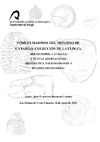Please use this identifier to cite or link to this item:
https://accedacris.ulpgc.es/jspui/handle/10553/7718
| Title: | Fósiles marinos del Neógeno de Canarias (Colección de la ULPGC): dos neotipos, catálogo y nuevas aportaciones (Sistemática, Paleoecología y Paleoclimatología) | Authors: | Betancort Lozano, Juan Francisco | Director: | Meco Cabrera, Joaquín Francisco | UNESCO Clasification: | 241601 Paleontología animal 240106 Ecología animal 250205 Paleoclimatología 2506 Geología |
Keywords: | Paleoecología Paleoceanografía Islas Canarias Neógeno terminal Atlántico Norte |
Issue Date: | 2012 | Abstract: | Se estudia el contenido faunístico de los depósitos sedimentarios fosilíferos de
edad mio-pliocena presentes en Gran Canaria, Fuerteventura y Lanzarote para obtener
información de tipo paleontológica, paleoclimática y paleoceanográfica.
Los trabajos anteriores que intentan interpretar estos niveles y su fauna se inician
en el siglo XIX con los trabajos de Cocchi (1875) y Rothpletz & Simonelli (1890) que
definen una serie de especies nuevas y paleoendemismos cuyos tipos y paratipos en
muchos casos se han perdido.
Conjuntamente al estudio de las especies presentes en los depósitos y a la
obtención de datos ecológicos y climáticos dentro del marco de Canarias y su relación
con depósitos en el Atlántico Norte y Mediterráneo, se definen 2 neotipos cuyos
holotipos fueron destruidos en la Segunda Guerra Mundial.
Se han recorrido todos los afloramientos de Canarias, estudiándose de forma
complementaria los especímenes fósiles de colecciones tanto privadas como de la
Universidad de Las Palmas de Gran Canaria, (Departamento de Biología), mediante la
taxonomía, con especial atención a la distribución geográfica y estratigráfica. The climatic and ecological conditions in the Canary Islands during the Last Neogene are raised in this work thanks to the study of the fauna in the fosiliferous sedimentary levels from Mio-pliocene age in Gran Canaria, Fuerteventura and Lanzarote, which has let us obtain paleontological, paleoclimatical and paleoceanographical information. Previous works over these sedimentary levels in the Canary Island started in the XIX Century with the works made by Cocchi (1875) and Rothpletz & Simonelli (1890), describing some new species and genus, as paleoendemis, which types or paratypes have been lost. Together with the study of the fossil fauna observed and the obtaining of ecological and climatic information, the understanding of this period within the frame of the Canary Islands and its relation to raised beaches levels in the North Atlantic and the Mediterranean, we have carried out the definition of two neotypes, whose holotypes were destroyed in the Second World War. For this work we have visited all the outcrops in the Canaries, studying their fossil content, by means of a taxonomic analysis, paying special attention to the geographical and stratigraphical distribution. In addition, we have also study private and public collections such as the one in the University of Las Palmas de Gran Canaria at the Biology Department. |
Description: | Programa de doctorado: Ecología y gestión de los recursos vivos marinos (bienio 2003-2005) | Department: | Biología | Faculty: | Facultad de Ciencias del Mar | URI: | https://accedacris.ulpgc.es/handle/10553/7718 | Rights: | by-nc-nd |
| Appears in Collections: | Tesis doctoral |
Page view(s)
397
checked on Oct 28, 2023
Download(s)
2,688
checked on Oct 28, 2023
Google ScholarTM
Check
Share
Export metadata
Items in accedaCRIS are protected by copyright, with all rights reserved, unless otherwise indicated.
